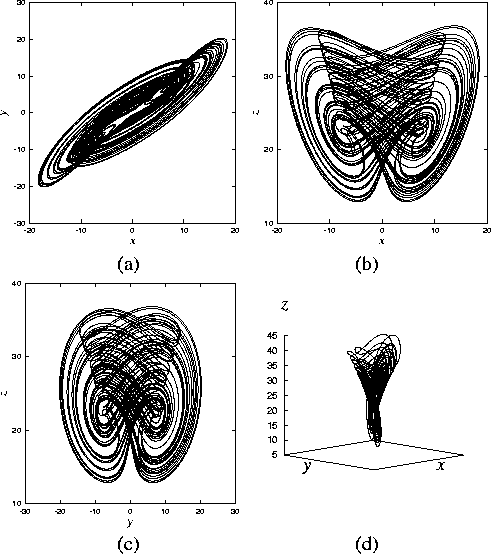 |
 |
Figures 14(a)-(c) show Poincare mapping on several sections. Several sheets of the attractors are visualized. In Fig. 14(d), it is clear that some sheets are folded.
Figure 15 shows the shapes of the stable manifolds
for ![]() . These one-dimensional manifolds wander
over the chaotic attractor. Note that stability of these stable
manifolds (negative eigenvalue) around
. These one-dimensional manifolds wander
over the chaotic attractor. Note that stability of these stable
manifolds (negative eigenvalue) around ![]() is very strong.
is very strong.
Let us summarize how the attractor is formed.
The orbit starting from an initial point whose values are
sufficiently big must move to the ![]() portion of equilibria
because the instability of the unstable manifold of
portion of equilibria
because the instability of the unstable manifold of ![]() is very
strong and grows up toward
is very
strong and grows up toward ![]() . Then the orbit draws elliptically
in the
. Then the orbit draws elliptically
in the ![]() -
-![]() plane, decreasing the value
plane, decreasing the value ![]() . It flows along the
stable manifold of
. It flows along the
stable manifold of ![]() , and takes a shape like a spiral in the
, and takes a shape like a spiral in the
![]() -
-![]() or
or ![]() -
-![]() plane. After this, the orbit reached near
plane. After this, the orbit reached near ![]() goes away rapidly and scarcely turns on the 2-dimensionally unstable
manifold of
goes away rapidly and scarcely turns on the 2-dimensionally unstable
manifold of ![]() since the real part of the unstable eigenvalue
is comparatively big. The orbit is then trapped into the unstable
chaos as shown in Fig. 5 (i) for awhile. Finally, the
orbit is lifted up along the unstable manifold of
since the real part of the unstable eigenvalue
is comparatively big. The orbit is then trapped into the unstable
chaos as shown in Fig. 5 (i) for awhile. Finally, the
orbit is lifted up along the unstable manifold of ![]() . We can see
that the stable manifolds of
. We can see
that the stable manifolds of ![]() plays an important role in
the generation of the strange attractor.
plays an important role in
the generation of the strange attractor.